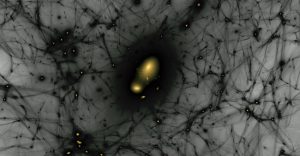
One of the great unknowns of nearly the past one hundred years is the identity of the invisible stuff that makes up the bulk of the matter in our galaxy and others. Called dark matter, this stuff can exert gravitational pulls but doesn’t absorb, emit, or reflect light. We can see where dark matter is located from that gravitational pull, but that doesn’t let us see what it is. Current theories don’t quite explain the new details about our universe that we’re learning from Webb’s images of the earliest galaxies or studies of modern galaxies that find the variability in the amount of dark matter exceeds the variability expected from our current theory, which is called cold dark matter.
And when one theory doesn’t quite match reality, new theories get explored. The two greatest limitations on our ability to understand our universe are the technologies we use to run models of our theories and the creativity of the theorists who come up with those theories.
A new paper in The Astrophysical Journal, by Ethan O. Nadler, Daneng Yang, and Hai-Bo Yu, shows that they have the creativity to take our understanding potentially one step forward.
Specifically, they asked what would happen if dark matter particles could self-interact. This means that while most particles we’re used to may not interact with dark matter particles, dark matter will interact with dark matter.
According to Nagler, “These self-interactions lead to heat transfer in the halo, which diversifies the halo density in the central regions of galaxies. In other words, some halos have higher central densities, and others have lower central densities, compared to their Cold Dark Matter counterparts, with details depending on the cosmic evolution history and environment of individual halos.”
Self-interacting dark matter isn’t new, but this paper introduces some new details; they make dark matter strongly interacting and explore the extremes of low-mass galaxies with a lot of dark matter and with a very low proportion of dark matter. They found they could successfully reproduce the actual systems we see, which isn’t possible with the standard cold dark matter model or other variations of the interacting dark matter model.
This isn’t the team’s first paper on Strongly Interacting Dark Matter. Across a series of papers, they have worked to define their theory and then apply it to different scenarios, including the diversity of dark matter halos found around galaxies near the Milky Way. This work will need to be replicated by other teams and applied to additional populations of objects before it can become a leading theory, but this research has my attention, and we’ll be following their progress.
